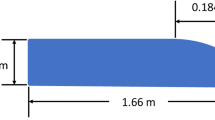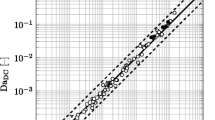Abstract
Experimental data obtained in shock tubes, including ignition delay-time and species concentration profiles, are among the most significant parameters in combustion studies. Although shock tubes are widely considered as a quasi-ideal reactor for high-temperature studies, it involves a number of non-ideal effects such as a time-dependent pressure increase within the test section. This non-ideal pressure rise induces inaccuracy in the shock tube measurements. To overcome this issue, the driver insert strategy has proven to be successful. Nevertheless, the approaches presented in the literature to design such a driver insert either are not self-sufficient, i.e., they rely on external software, or lack flexibility. In this study, a simple, self-sufficient, fully analytical approach implemented in a MATLAB code has been developed to design a driver insert for the control of the rate of pressure rise in the test volume. The tip and end positions of the insert, as well as the effect of area change ratio on pressure behind reflected shock are obtained by the code. Extensive validation is performed against previous results from the literature and new data generated with several numerical codes.










Similar content being viewed by others
Data availability
The data generated during the present study are available from the corresponding author on reasonable request.
References
Mével, R., Javoy, S., Lafosse, F., Chaumeix, N., Dupré, G., Paillard, C.-E.: Hydrogen-nitrous oxide delay time: shock tube experimental study and kinetic modelling. Proc. Combust. Inst. 32, 359–366 (2009). https://doi.org/10.1016/j.proci.2008.06.171
Mével, R., Javoy, S., Dupré, G.: A chemical kinetic study of the oxidation of silane by nitrous oxide, nitric oxide and oxygen. Proc. Combust. Inst. 33, 485–492 (2011). https://doi.org/10.1016/j.proci.2010.05.076
Gaydon, A.G., Hurle, I.R.: The Shock-Tube in High-Temperature Chemical Physics. Chapman and Hall Ltd, London (1963). https://doi.org/10.1017/S0001924000061741
Bhaskaran, K.A., Roth, P.: The shock tube as wave reactor for kinetic studies and materials systems. Prog. Energy Combust. Sci. 28, 151–192 (2002). https://doi.org/10.1016/S0360-1285(01)00011-9
Pang, G.A., Davidson, D.F., Hanson, R.K.: Experimental study and modeling of shock tube ignition delay times for hydrogen-oxygen-argon mixtures at low temperatures. Proc. Combust. Inst. 32, 181–188 (2009). https://doi.org/10.1016/j.proci.2008.06.014
Li, H., Owens, Z.C., Davidson, D.F., Hanson, R.K.: A simple reactive gasdynamic model for the computation of gas temperature and species concentrations behind reflected shock waves. Int. J. Chem. Kinet. 40, 189–198 (2008). https://doi.org/10.1002/kin.20305
Chaos, M., Dryer, F.L.: Chemical-kinetic modeling of ignition delay: considerations in interpreting shock tube data. Int. J. Chem. Kinet. 42, 143–150 (2010). https://doi.org/10.1002/kin.20471
Dumitrescu, L.Z.: An attenuation-free shock tube. Phys. Fluids 15, 207–209 (1972). https://doi.org/10.1063/1.1693742
Hong, Z., Pang, G.A., Vasu, S.S., Davidson, D.F., Hanson, R.K.: The use of driver inserts to reduce non-ideal pressure variations behind reflected shock waves. Shock Waves 19, 113–123 (2009). https://doi.org/10.1007/s00193-009-0205-y
Bonazza, R.: x–t Diagram Tools. Available online at: http://silver.neep.wisc.edu/shock/tools/xt.html
Hanson, R.K., Davidson, D.F.: Recent advances in laser absorption and shock tube methods for studies of combustion chemistry. Prog. Energy Combust. Sci. 44, 103–114 (2014). https://doi.org/10.1016/j.pecs.2014.05.001
Ferris, A.M., Susa, A.J., Davidson, D.F., Hanson, R.K.: High-temperature laminar flame speed measurements in a shock tube. Combust. Flame 205, 241–252 (2019). https://doi.org/10.1016/j.combustflame.2019.04.007
Nativel, D.: Chemical kinetic study of biofuels oxidation. Ph.D. dissertation, Université d’Orléans (2015)
Mehta, J.M.: Optimization of pressure and temperature characteristics of a high pressure shock tube. Master thesis, University of Illinois at Chicago (2018). https://hdl.handle.net/10027/22678
Grogan, K., Ihme, M.: StanShock: a gas-dynamic model for shock tube simulations with non-ideal effects and chemical kinetics. Shock Waves 30, 425–438 (2020). https://doi.org/10.1007/s00193-019-00935-x
Loubsky, W.J., Reller, J.O.: Analysis of tailored-interface operation of shock tubes with helium-driven planetary gases. Technical report NASA-TN-D-3495 (1966). https://ntrs.nasa.gov/citations/19660020190
Holder. A note on shock tubes. Technical report, National Physical Laboratory (1953). https://citeseerx.ist.psu.edu/document?repid=rep1 &type=pdf &doi=b2cc5a6d3a120dbb36eae16e8917cc075069509b
Alpher, R.A., White, D.R.: Flow in shock tubes with area change at the diaphragm section. J. Fluid Mech. 3, 457–470 (1958). https://doi.org/10.1017/S0022112058000124
Mathieu, O., Levacque, A., Petersen, E.L.: Effects of NO\(_{2}\) addition on hydrogen ignition behind reflected shock waves. Proc. Combust. Inst. 34, 633–640 (2013). https://doi.org/10.1016/j.proci.2012.05.067
Hong, Z., Davidson, D.F., Hanson, R.K.: Contact surface tailoring condition for shock tubes with different driver and driven section diameters. Shock Waves 19, 331–336 (2009). https://doi.org/10.1007/s00193-009-0212-z
Author information
Authors and Affiliations
Corresponding author
Ethics declarations
Conflict of interest
The authors have no conflict of interest to report.
Additional information
Communicated by G. Ciccarelli.
Publisher's Note
Springer Nature remains neutral with regard to jurisdictional claims in published maps and institutional affiliations.
This paper is based on work that was presented at the 29th International Colloquium on the Dynamics of Explosions and Reactive Systems (ICDERS), Siheung, Korea, July 23–28, 2023.
Rights and permissions
Springer Nature or its licensor (e.g. a society or other partner) holds exclusive rights to this article under a publishing agreement with the author(s) or other rightsholder(s); author self-archiving of the accepted manuscript version of this article is solely governed by the terms of such publishing agreement and applicable law.
About this article
Cite this article
Tan, Y., Li, Z. & Mével, R. A simple, self-sufficient approach for the design of shock tube driver insert. Shock Waves (2024). https://doi.org/10.1007/s00193-024-01157-6
Received:
Revised:
Accepted:
Published:
DOI: https://doi.org/10.1007/s00193-024-01157-6




